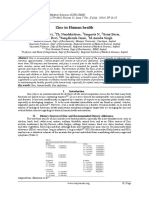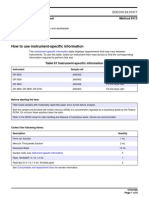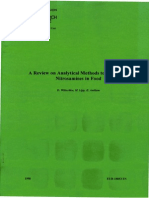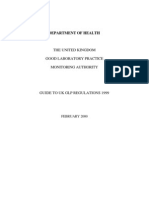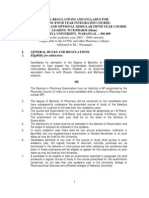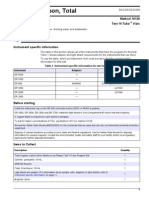Water For Injections
Water For Injections
Uploaded by
Alvina Arum PuspitasariCopyright:
Available Formats
Water For Injections
Water For Injections
Uploaded by
Alvina Arum PuspitasariOriginal Description:
Original Title
Copyright
Available Formats
Share this document
Did you find this document useful?
Is this content inappropriate?
Copyright:
Available Formats
Water For Injections
Water For Injections
Uploaded by
Alvina Arum PuspitasariCopyright:
Available Formats
Water for injections
EUROPEAN PHARMACOPOEIA 5.0
with reference solution (c) shows two clearly separated spots
and the chromatogram obtained with reference solution (a)
shows a clearly visible spot.
Phenolic ketones. Dissolve 1.25 g in a 20 g/l solution of
sodium hydroxide R and dilute to 10.0 ml with the same
solvent. The absorbance (2.2.25), measured at 385 nm within
IDENTIFICATION
15 min of preparing the solution, is not greater than 0.20.
First identification : B, D, E.
Propan-2-ol : 8.0 per cent m/m to 8.5 per cent m/m,
Second identification : A, C, D, E.
determined by gas chromatography (2.2.28) using
A. Dissolve 1 g in 25 ml of water R, add 2 ml of dilute
propanol R as internal standard.
hydrochloric acid R and filter. Reserve the filtrate for
Internal standard solution. Dilute 1.0 ml of propanol R to
identification test E. The precipitate, washed with water R
200.0 ml with water R.
and dried at 100 C to 105 C, melts (2.2.14) at 159 C
Test solution (a). Dissolve 0.250 g of the substance to be
to 163 C.
examined in water R and dilute to 5.0 ml with the same
B. Dissolve 1 g in 25 ml of water R, add 2 ml of dilute
solvent.
hydrochloric acid R and filter. Reserve the filtrate for
identification test E. Examine the precipitate by infrared Test solution (b). Dissolve 0.50 g of the substance to be
examined in the internal standard solution and dilute to
absorption spectrophotometry (2.2.24) comparing with
10.0 ml with the internal standard solution.
the spectrum obtained with the precipitate prepared in
Reference solution. Dilute 0.50 ml of propan-2-ol R to
the same manner from warfarin sodium CRS.
100.0 ml with the internal standard solution.
C. Examine the chromatograms obtained in the test
The chromatographic procedure may be carried out using :
for related substances. The principal spot in the
chromatogram obtained with test solution (b) is
a column 1.5 m long and 4 mm in internal diameter packed
similar in position and size to the principal spot in the
with ethylvinylbenzene-divinylbenzene copolymer R
chromatogram obtained with reference solution (b).
(125 m to 150 m),
nitrogen
for chromatography R as the carrier gas at a
D. Dissolve 1 g in 10 ml of water R, add 5 ml of nitric
flow rate of 40 ml/min,
acid R and filter. To the filtrate add 2 ml of potassium
dichromate solution R1 and shake for 5 min. Allow to
a flame-ionisation detector,
stand for 20 min. The solution is greenish-blue when
maintaining the temperature of the column at 150 C, that
compared with a blank.
of the injection port at 180 C and that of the detector at
E. The filtrate obtained in identification test A or B gives
200 C. Inject the selected volumes of the test solutions and
reaction (b) of sodium (2.3.1).
the reference solution. Calculate the content of propan-2-ol
taking its density at 20 C to be 0.785 g/ml.
TESTS
Water (2.5.12). Not more than 0.1 per cent, determined on
Appearance of solution. Dissolve 1.0 g in water R and dilute 2.500 g by the semi-micro determination of water.
to 20 ml with the same solvent. The solution is clear (2.2.1)
ASSAY
and colourless (2.2.2, Method II).
Dissolve 0.1000 g in 0.01 M sodium hydroxide and dilute
pH (2.2.3). Dissolve 1.0 g in carbon dioxide-free water R
to 100.0 ml with the same solvent. Dilute 10.0 ml of this
and dilute to 100 ml with the same solvent. The pH of the
solution to 100.0 ml with 0.01 M sodium hydroxide. Dilute
solution is 7.6 to 8.6.
10.0 ml of the latter solution to 100.0 ml with 0.01 M
Related substances. Examine by thin-layer chromatography sodium hydroxide. Measure the absorbance (2.2.25) at the
(2.2.27), using silica gel GF254 R as the coating substance.
maximum at 308 nm.
Test solution (a). Dissolve 0.20 g of the substance to be
Calculate the content of C19H15NaO4 taking the specific
examined in acetone R and dilute to 10 ml with the same
absorbance to be 431.
solvent.
STORAGE
Test solution (b). Dilute 2 ml of test solution (a) to 10 ml
Store in an airtight container, protected from light.
with acetone R.
Reference solution (a). Dilute 1 ml of test solution (b) to
200 ml with acetone R.
01/2005:0169
Reference solution (b). Dissolve 40 mg of warfarin
corrected
sodium CRS in acetone R and dilute to 10 ml with the same
solvent.
WATER FOR INJECTIONS
Reference solution (c). Dissolve 10 mg of
acenocoumarol CRS in acetone R, add 1 ml of test
solution (a) and dilute to 10 ml with acetone R.
Aqua ad iniectabilia
Apply separately to the plate 20 l of each solution. Develop
Mr 18.02
over a path of 15 cm using a mixture of 20 volumes of glacial H2O
acetic acid R, 50 volumes of methylene chloride R and
DEFINITION
50 volumes of cyclohexane R. Allow the plate to dry in air
and examine in ultraviolet light at 254 nm. Any spot in the
Water for the preparation of medicines for parenteral
chromatogram obtained with test solution (a), apart from
administration when water is used as vehicle (water for
the principal spot, is not more intense than the spot in the
injections in bulk) and for dissolving or diluting substances
chromatogram obtained with reference solution (a) (0.1 per or preparations for parenteral administration (sterilised
cent). The test is not valid unless the chromatogram obtained water for injections).
CHARACTERS
A white powder, very soluble in water, freely soluble in
alcohol, soluble in acetone, very slightly soluble in methylene
chloride.
2692
See the information section on general monographs (cover pages)
Water for injections
EUROPEAN PHARMACOPOEIA 5.0
Water for injections in bulk
PRODUCTION
Table 0169.-1. Stage 1 - Temperature and conductivity
requirements (for non-temperature-compensated
conductivity measurements)
Water for injections in bulk is obtained from water that
complies with the regulations on water intended for human
consumption laid down by the competent authority or
from purified water by distillation in an apparatus of which
the parts in contact with the water are of neutral glass,
quartz or suitable metal and which is fitted with an effective
device to prevent the entrainment of droplets. The correct
maintenance of the apparatus is essential. The first portion
of the distillate obtained when the apparatus begins to
function is discarded and the distillate is collected.
Temperature
(C)
0
Conductivity
(Scm 1)
0.6
0.8
10
0.9
15
1.0
20
1.1
25
1.3
During production and subsequent storage, appropriate
measures are taken to ensure that the total viable aerobic
count is adequately controlled and monitored. Appropriate
alert and action limits are set so as to detect adverse trends.
Under normal conditions, an appropriate action limit is a
total viable aerobic count (2.6.12) of 10 micro-organisms
per 100 ml when determined by membrane filtration, using
agar medium S, using at least 200 ml of water for injections
in bulk and incubating at 30-35 C for 5 days. For aseptic
processing, stricter alert limits may need to be applied.
Total organic carbon (2.2.44) : maximum 0.5 mg/l.
30
1.4
35
1.5
40
1.7
45
1.8
Conductivity. Determine the conductivity off-line or in-line
under the following conditions.
EQUIPMENT
Conductivity cell :
50
1.9
55
2.1
60
2.2
65
2.4
70
2.5
75
2.7
80
2.7
85
2.7
electrodes of a suitable material such as stainless steel ;
90
2.7
cell constant : within 2 per cent of the given value
determined using a certified reference solution with a
conductivity less than 1500 Scm 1.
95
2.9
100
3.1
Conductometer : resolution 0.1 Scm 1 on the lowest range. Stage 2
System calibration (conductivity cell and conductometer) : 4. Transfer a sufficient amount of the water to be examined
against one or more suitable certified standard solutions ;
accuracy : within 3 per cent of the measured conductivity
plus 0.1 Scm 1.
Conductometer calibration : by means of precision resistors
or equivalent devices, after disconnecting the conductivity
cell, for all ranges used for conductivity measurement and
cell calibration (with an accuracy within 0.1 per cent of the
stated value, traceable to the official standard).
If in-line conductivity cells cannot be dismantled, system
calibration may be performed against a calibrated
conductivity cell placed close to the cell to be calibrated in
the water flow.
(100 ml or more) to a suitable container, and stir the test
sample. Adjust the temperature, if necessary, and while
maintaining it at 25 1 C, begin vigorously agitating the
test sample while periodically observing the conductivity.
When the change in conductivity (due to uptake of
atmospheric carbon dioxide) is less than 0.1 S.cm 1 per
5 min, note the conductivity.
5. If the conductivity is not greater than 2.1 S.cm 1, the
water to be examined meets the requirements of the
test for conductivity. If the conductivity is greater than
2.1 S.cm 1, proceed with stage 3.
Stage 3
6. Perform this test within approximately 5 min of the
conductivity determination in step 5 under stage 2, while
maintaining the sample temperature at 25 1 C. Add
1. Measure the conductivity without temperature
a recently prepared saturated solution of potassium
compensation, recording simultaneously the temperature.
chloride R to the test sample (0.3 ml per 100 ml of the
Temperature-compensated measurement may be
test sample), and determine the pH (2.2.3) to the nearest
performed after suitable validation.
0.1 pH unit.
2. Using Table 0169.-1, find the closest temperature value
7. Using Table 0169.-2, determine the conductivity limit
that is not greater than the measured temperature. The
at the measured pH value in step 6. If the measured
corresponding conductivity value is the limit at that
conductivity in step 4 under stage 2 is not greater than
temperature.
the conductivity requirements for the pH determined,
3. If the measured conductivity is not greater than the
the water to be examined meets the requirements of the
value in Table 0169.-1, the water to be examined meets
test for conductivity. If either the measured conductivity
the requirements of the test for conductivity. If the
is greater than this value or the pH is outside the range
conductivity is higher than the value in Table 0169.-1,
of 5.0-7.0, the water to be examined does not meet the
proceed with stage 2.
requirements of the test for conductivity.
PROCEDURE
Stage 1
General Notices (1) apply to all monographs and other texts
2693
Water for injections
EUROPEAN PHARMACOPOEIA 5.0
Heavy metals (2.4.8) : maximum 0.1 ppm.
Table 0169.-2. Stage 3 - pH and conductivity
requirements (for atmosphere and temperature equilibrated Heat 200 ml in a glass evaporating dish on a water-bath until
samples)
the volume is reduced to 20 ml. 12 ml of the concentrated
pH
Conductivity
solution complies with limit test A. Prepare the standard
(Scm 1)
using 10 ml of lead standard solution (1 ppm Pb) R.
4.7
5.0
Bacterial endotoxins (2.6.14) : less than 0.25 IU/ml.
5.1
4.1
5.2
3.6
5.3
3.3
5.4
3.0
5.5
2.8
5.6
2.6
5.7
2.5
5.8
2.4
5.9
2.4
6.0
2.4
6.1
2.4
6.2
2.5
Sterilised water for injections
DEFINITION
Water for injections in bulk that has been distributed
into suitable containers, closed and sterilised by heat in
conditions which ensure that the product still complies
with the test for bacterial endotoxins. Sterilised water for
injections is free from any added substances.
Examined in suitable conditions of visibility, it is clear and
colourless.
Each container contains a sufficient quantity of water for
injections to permit the nominal volume to be withdrawn.
TESTS
Acidity or alkalinity. To 20 ml add 0.05 ml of phenol
6.3
2.4
red solution R. If the solution is yellow, it becomes red
on the addition of 0.1 ml of 0.01 M sodium hydroxide ;
6.4
2.3
if red, it becomes yellow on the addition of 0.15 ml of
2.2
6.5
0.01 M hydrochloric acid.
6.6
2.1
Conductivity : maximum 25 Scm 1 for containers with a
nominal volume of 10 ml or less ; maximum 5 Scm 1 for
6.7
2.6
containers with a nominal volume greater than 10 ml.
6.8
3.1
Use equipment and the calibration procedure as defined
6.9
3.8
under Water for injections in bulk, maintaining the sample
temperature at 25 1 C.
7.0
4.6
Oxidisable substances. Boil 100 ml with 10 ml of dilute
In order to ensure the appropriate quality of the water,
sulphuric acid R. Add 0.2 ml of 0.02 M potassium
validated procedures and in-process-monitoring of the
permanganate and boil for 5 min. The solution remains
electrical conductivity and regular microbial monitoring are faintly pink.
applied.
Chlorides (2.4.4) : maximum 0.5 ppm for containers with a
Water for injections in bulk is stored and distributed in
nominal volume of 100 ml or less.
conditions designed to prevent growth of micro-organisms
15 ml complies with the limit test for chlorides. Prepare
and to avoid any other contamination.
the standard using a mixture of 1.5 ml of chloride standard
solution (5 ppm Cl) R and 13.5 ml of water R. Examine the
CHARACTERS
solutions down the vertical axes of the tubes.
Appearance : clear and colourless liquid.
For containers with a nominal volume greater than 100 ml,
TESTS
use the following test : to 10 ml add 1 ml of dilute nitric
acid R and 0.2 ml of silver nitrate solution R2. The solution
Nitrates : maximum 0.2 ppm.
shows no change in appearance for at least 15 min.
Place 5 ml in a test-tube immersed in iced water, add 0.4 ml
Nitrates : maximum 0.2 ppm.
of a 100 g/l solution of potassium chloride R, 0.1 ml of
diphenylamine solution R and, dropwise with shaking,
Place 5 ml in a test-tube immersed in iced water, add 0.4 ml
5 ml of nitrogen-free sulphuric acid R. Transfer the tube
of a 100 g/l solution of potassium chloride R, 0.1 ml of
to a water-bath at 50 C. After 15 min, any blue colour in
diphenylamine solution R and, dropwise with shaking,
the solution is not more intense than that in a reference
5 ml of nitrogen-free sulphuric acid R. Transfer the tube
solution prepared at the same time in the same manner
to a water-bath at 50 C. After 15 min, any blue colour in
using a mixture of 4.5 ml of nitrate-free water R and 0.5 ml the solution is not more intense than that in a reference
of nitrate standard solution (2 ppm NO3) R.
solution prepared at the same time in the same manner
Aluminium (2.4.17) : maximum 10 ppb, if intended for use in using a mixture of 4.5 ml of nitrate-free water R and 0.5 ml
of nitrate standard solution (2 ppm NO3) R.
the manufacture of dialysis solutions.
Sulphates.
To 10 ml add 0.1 ml of dilute hydrochloric acid R
Prescribed solution. To 400 ml of the water to be examined
add 10 ml of acetate buffer solution pH 6.0 R and 100 ml of and 0.1 ml of barium chloride solution R1. The solution
shows no change in appearance for at least 1 h.
distilled water R.
Aluminium (2.4.17) : maximum 10 ppb, if intended for use in
Reference solution. Mix 2 ml of aluminium standard
the manufacture of dialysis solutions.
solution (2 ppm Al) R, 10 ml of acetate buffer solution
pH 6.0 R and 98 ml of distilled water R.
Prescribed solution. To 400 ml of the water to be examined
Blank solution. Mix 10 ml of acetate buffer solution
add 10 ml of acetate buffer solution pH 6.0 R and 100 ml of
pH 6.0 R and 100 ml of distilled water R.
distilled water R.
2694
See the information section on general monographs (cover pages)
Water, highly purified
EUROPEAN PHARMACOPOEIA 5.0
Reference solution. Mix 2 ml of aluminium standard
solution (2 ppm Al) R, 10 ml of acetate buffer solution
pH 6.0 R and 98 ml of distilled water R.
Blank solution. Mix 10 ml of acetate buffer solution
pH 6.0 R and 100 ml of distilled water R.
Current production methods include for example double-pass
reverse osmosis coupled with other suitable techniques such
as ultrafiltration and deionisation. Correct operation and
maintenance of the system is essential.
During production and subsequent storage, appropriate
measures are taken to ensure that the total viable aerobic
count is adequately controlled and monitored. Appropriate
To 20 ml add 1 ml of alkaline potassium tetraiodomercurate alert and action limits are set so as to detect adverse trends.
solution R. After 5 min, examine the solution down the
Under normal conditions, an appropriate action limit is a
vertical axis of the tube. The solution is not more intensely total viable aerobic count (2.6.12) of 10 micro-organisms
coloured than a standard prepared at the same time by
per 100 ml when determined by membrane filtration, using
adding 1 ml of alkaline potassium tetraiodomercurate
agar medium S, at least 200 ml of highly purified water and
solution R to a mixture of 4 ml of ammonium standard
incubating at 30-35 C for 5 days.
solution (1 ppm NH4) R and 16 ml of ammonium-free
Total organic carbon (2.2.44) : maximum 0.5 mg/l.
water R.
Ammonium : maximum 0.2 ppm.
Calcium and magnesium. To 100 ml add 2 ml of ammonium Conductivity. Determine the conductivity off-line or in-line
chloride buffer solution pH 10.0 R, 50 mg of mordant
under the following conditions.
black 11 triturate R and 0.5 ml of 0.01 M sodium edetate. A
EQUIPMENT
pure blue colour is produced.
Conductivity cell :
Heavy metals (2.4.8) : maximum 0.1 ppm.
Heat 200 ml in a glass evaporating dish on a water-bath until electrodes of a suitable material such as stainless steel ;
the volume is reduced to 20 ml. 12 ml of the concentrated
solution complies with limit test A. Prepare the standard
cell constant : within 2 per cent of the given value
using 10 ml of lead standard solution (1 ppm Pb) R.
determined using a certified reference solution with a
conductivity less than 1500 Scm 1.
Residue on evaporation : maximum 4 mg (0.004 per cent) for
containers with a nominal volume of 10 ml or less ; maximum
3 mg (0.003 per cent ) for containers with a nominal volume Conductometer : resolution 0.1 Scm 1 on the lowest range.
greater than 10 ml.
Evaporate 100 ml to dryness on a water-bath and dry in an
oven at 100-105 C.
System calibration (conductivity cell and conductometer) :
Particulate contamination : sub-visible particles (2.9.19). It against one or more suitable certified standard solutions ;
complies with test A or test B, as appropriate.
accuracy : within 3 per cent of the measured conductivity
Sterility (2.6.1). It complies with the test for sterility.
plus 0.1 Scm 1.
Bacterial endotoxins (2.6.14) : less than 0.25 IU/ml.
Conductometer calibration : by means of precision resistors
or equivalent devices after disconnecting the conductivity
cell, for all ranges used for conductivity measurement and
cell calibration (with an accuracy within 0.1 per cent of the
stated value, traceable to the official standard).
WATER, HIGHLY
01/2005:1927
corrected If in-line conductivity cells cannot be dismantled, system
calibration may be performed against a calibrated
conductivity cell placed close to the cell to be calibrated in
the water flow.
PURIFIED
PROCEDURE
Stage 1
Aqua valde purificata
H 2O
1. Measure the conductivity without temperature
compensation, recording simultaneously the temperature.
Mr 18.02
Temperature-compensated measurement may be
performed after suitable validation.
DEFINITION
Water intended for use in the preparation of medicinal
products where water of high biological quality is needed,
except where Water for injections (0169) is required.
PRODUCTION
Highly purified water is obtained from water that complies
with the regulations on water intended for human
consumption laid down by the competent authority.
General Notices (1) apply to all monographs and other texts
2. Using Table 1927.-1, find the closest temperature value
that is not greater than the measured temperature. The
corresponding conductivity value is the limit at that
temperature.
3. If the measured conductivity is not greater than the
value in Table 1927.-1, the water to be examined meets
the requirements of the test for conductivity. If the
conductivity is higher than the value in Table 1927.-1,
proceed with stage 2.
2695
You might also like
- The Performance Comparison of Ultrapure Water Total Organic Carbon (TOC) Analyzers Using An Automated Standard Addition ApparatusDocument10 pagesThe Performance Comparison of Ultrapure Water Total Organic Carbon (TOC) Analyzers Using An Automated Standard Addition ApparatusRichardGodecNo ratings yet
- Mass Spectrometry Dry Lab CHM 1021Document7 pagesMass Spectrometry Dry Lab CHM 1021himaNo ratings yet
- Note Guidance Manufacture Finished Dosage Form enDocument7 pagesNote Guidance Manufacture Finished Dosage Form enseshadriNo ratings yet
- FDA Warning LetterDocument10 pagesFDA Warning LetterKwabena Agyeman100% (1)
- PFDA Registration RequirementsDocument4 pagesPFDA Registration RequirementsRosenda Monette100% (1)
- E013721823 PDFDocument6 pagesE013721823 PDFAbeiasaNo ratings yet
- Chapter 60 - Insulin, Oral Hypoglycaemic Agents, and The Pharmacology of The Endocrine PancreasDocument17 pagesChapter 60 - Insulin, Oral Hypoglycaemic Agents, and The Pharmacology of The Endocrine PancreasGiliana P. García AcevedoNo ratings yet
- BS Water Treatment Presentation 1 1Document44 pagesBS Water Treatment Presentation 1 1wan yeeNo ratings yet
- HACH Chloride by Thiocyanate-Method No.8113-DOC316.53.01017 - Ed7Document6 pagesHACH Chloride by Thiocyanate-Method No.8113-DOC316.53.01017 - Ed7Balas43No ratings yet
- Impurity Profiling of Pharmaceuticals PDFDocument15 pagesImpurity Profiling of Pharmaceuticals PDFvikram kushwahaNo ratings yet
- LC by DesingDocument12 pagesLC by DesingsudermanfitoNo ratings yet
- Second Year B. Pharm 2019 PatternDocument64 pagesSecond Year B. Pharm 2019 Patternvaibhavi maliNo ratings yet
- Functional Group AnalysisDocument2 pagesFunctional Group AnalysisPharmacist97No ratings yet
- B.Pharm. - Evaluation Scheme & Syllabus - (2nd Year) - As Per PCI PDFDocument33 pagesB.Pharm. - Evaluation Scheme & Syllabus - (2nd Year) - As Per PCI PDFNaman ShahNo ratings yet
- ملزمة رقابة - نسخةDocument68 pagesملزمة رقابة - نسخةتامر الصينيNo ratings yet
- Acquity UPLC H-ClassDocument6 pagesAcquity UPLC H-Classchaerul.anwar554No ratings yet
- Safety in Chemical LaboratoryDocument7 pagesSafety in Chemical LaboratoryMaheshNo ratings yet
- Care of HPLC ColumnsDocument4 pagesCare of HPLC ColumnsKavisa GhoshNo ratings yet
- GC-MS-MS Analysis of Pesticide Residues in Green Tea Extracted by QuEChERSDocument1 pageGC-MS-MS Analysis of Pesticide Residues in Green Tea Extracted by QuEChERSAmerican Lab100% (1)
- Water For Pharmaceutical Use: Water Purification and EngineeringDocument19 pagesWater For Pharmaceutical Use: Water Purification and EngineeringJosé Manuel Pais-ChanfrauNo ratings yet
- USP Medicines Compendium - Eflornithine Topical Cream - 2013-01-16Document3 pagesUSP Medicines Compendium - Eflornithine Topical Cream - 2013-01-16amin138irNo ratings yet
- How To Ensure Trouble-Free HPLC System OperationDocument3 pagesHow To Ensure Trouble-Free HPLC System OperationKavisa GhoshNo ratings yet
- Method HPLC of NitrosaminesDocument48 pagesMethod HPLC of NitrosaminesEmmaHuruniNo ratings yet
- Mhra - GLPDocument24 pagesMhra - GLPRambabu komati - QANo ratings yet
- Demystifying The Chromatographic ProcessDocument74 pagesDemystifying The Chromatographic ProcessDoni Eka PutraNo ratings yet
- Webinar CEP 2.0 May 2023Document51 pagesWebinar CEP 2.0 May 2023Julia ShulgaNo ratings yet
- Semester 3 Syllabus B PharmaDocument18 pagesSemester 3 Syllabus B Pharmaabhishek sharmaNo ratings yet
- HPLC Problem and TroubleshootingDocument8 pagesHPLC Problem and TroubleshootingarvinekoputrantoNo ratings yet
- Forced Degradation StudiesDocument9 pagesForced Degradation Studiesppiccolini100% (1)
- Annual Drinking Water Quality Report 2021Document14 pagesAnnual Drinking Water Quality Report 2021City of Longmont, ColoradoNo ratings yet
- Pipette CalibrationDocument4 pagesPipette CalibrationbalajivangaruNo ratings yet
- EPA Drinking Water Standards 2009Document30 pagesEPA Drinking Water Standards 2009SmicrumNo ratings yet
- Pharmaceutical Development and Compatibility Studies On Cytarabine InjectionDocument4 pagesPharmaceutical Development and Compatibility Studies On Cytarabine InjectionAmit KhuntNo ratings yet
- Factors Affecting Stability of Formulations: Dr. Satish A. Patel M. Pharm, Ph. DDocument38 pagesFactors Affecting Stability of Formulations: Dr. Satish A. Patel M. Pharm, Ph. DMr. HIMANSHU PALIWALNo ratings yet
- Patel Riddhiben M., Patel Piyushbhai M., Patel Natubhai MDocument9 pagesPatel Riddhiben M., Patel Piyushbhai M., Patel Natubhai Msandriss-2No ratings yet
- Manual For Testing of Water and Wastewater Treatment ChemicalsDocument307 pagesManual For Testing of Water and Wastewater Treatment ChemicalsprideNo ratings yet
- Simultaneous Determination of Methylparaben + Propylparaben + Hidrocortisone Topical Cream PDFDocument7 pagesSimultaneous Determination of Methylparaben + Propylparaben + Hidrocortisone Topical Cream PDFNájla KassabNo ratings yet
- Interpreting Mass SpectraDocument7 pagesInterpreting Mass SpectraManzNo ratings yet
- Determination of Trichloroacetic Acid Using HPLCDocument11 pagesDetermination of Trichloroacetic Acid Using HPLCLucia PuspitasariNo ratings yet
- Investigating From Instrument To Column 1684601941Document56 pagesInvestigating From Instrument To Column 1684601941AlexandreLuizdeSouzaNo ratings yet
- Water Quality TestingDocument20 pagesWater Quality Testingapi-26228968No ratings yet
- Determination of Solubility ClassDocument16 pagesDetermination of Solubility ClassAlyssa Alexis RamosNo ratings yet
- Column ClassificationDocument51 pagesColumn ClassificationHyunjung KimNo ratings yet
- Uplc HPLC: Pros and Cons Advantages of UPLC Over HPLCDocument1 pageUplc HPLC: Pros and Cons Advantages of UPLC Over HPLCSARAHI MOGUEL PEREZNo ratings yet
- USP-NF 1092 The Dissolution Procedure - Development and ValidationDocument26 pagesUSP-NF 1092 The Dissolution Procedure - Development and Validationmohamedzahafa2No ratings yet
- GCDocument9 pagesGCdamariamNo ratings yet
- 2881-2883 Diclofenac Sodium Delayed-Release TabletsDocument3 pages2881-2883 Diclofenac Sodium Delayed-Release Tabletsoktaviana catur nurlaila100% (1)
- Icp-Ms For UspDocument8 pagesIcp-Ms For UspNostimi SoupaNo ratings yet
- B.pharmacy SyllabusDocument74 pagesB.pharmacy SyllabusPraveen Johnny AlugojuNo ratings yet
- Chromatography 22 23 1Document142 pagesChromatography 22 23 1Anna mae AaronNo ratings yet
- Selection of DissolutionDocument5 pagesSelection of DissolutionGirishNo ratings yet
- 1.1 Analytical Chemistry: Introductio NDocument56 pages1.1 Analytical Chemistry: Introductio NmadhubaddapuriNo ratings yet
- HPLC Troubleshooting: Spinco Biotech PVT LTDDocument34 pagesHPLC Troubleshooting: Spinco Biotech PVT LTDskvemulaNo ratings yet
- HPLC TroubleshootingDocument27 pagesHPLC TroubleshootingwingroupsNo ratings yet
- OrganicCarbonTotalDirectTNT DOC316.53.01093Document8 pagesOrganicCarbonTotalDirectTNT DOC316.53.01093yocam2No ratings yet
- USP 37 281 Residue On Ignition 1Document1 pageUSP 37 281 Residue On Ignition 1David SRNo ratings yet
- Cleaning and disinfection of food factories: a practical guideFrom EverandCleaning and disinfection of food factories: a practical guideNo ratings yet
- Ch312 Mass Transfer-I: Unit-I: Numerical Problems-IDocument28 pagesCh312 Mass Transfer-I: Unit-I: Numerical Problems-Imayank sinhaNo ratings yet
- Flow Assurance in Subsea Production 01Document54 pagesFlow Assurance in Subsea Production 01Festus AdeyemoNo ratings yet
- Chapter 14. Washing, Leaching, and Supercritical Extraction: 14.1 Generalized Mccabe-Thiele and Kremser ProceduresDocument7 pagesChapter 14. Washing, Leaching, and Supercritical Extraction: 14.1 Generalized Mccabe-Thiele and Kremser ProceduresRobson2305No ratings yet
- IGCSE Chemistry NotesDocument46 pagesIGCSE Chemistry NotesAhmed SideegNo ratings yet
- Design of Agitated Leach CircuitDocument80 pagesDesign of Agitated Leach Circuitjoseph kafumbilaNo ratings yet
- Chap 3 - Mat Bal 02-1Document33 pagesChap 3 - Mat Bal 02-1iyla sallehNo ratings yet
- Lab Ac 5Document13 pagesLab Ac 5Najmi Nasir100% (3)
- Teal. A 2.É.: Aug. 7, 1945. W. J. Cotton 2,381,210Document4 pagesTeal. A 2.É.: Aug. 7, 1945. W. J. Cotton 2,381,210juzmailmaNo ratings yet
- Ind. J. Chem. 51B, 1470-1488 (2012) - Ecofriendly Process For PregabalinDocument19 pagesInd. J. Chem. 51B, 1470-1488 (2012) - Ecofriendly Process For Pregabalinsunil_vaman_joshiNo ratings yet
- 7 NipoDocument4 pages7 NipoK Geeth SagarNo ratings yet
- WHT Are Properties of Matter - Chemistry Chapter 1 Grade-6 ChemistryDocument8 pagesWHT Are Properties of Matter - Chemistry Chapter 1 Grade-6 ChemistryasaleemnaNo ratings yet
- (Viii) Formality (F) - : Mass of The Ionic Solute in Gram Per Litre Formula Mass of The SolutionDocument1 page(Viii) Formality (F) - : Mass of The Ionic Solute in Gram Per Litre Formula Mass of The SolutionAakash MalviyaNo ratings yet
- How Is Henry's Law Constant K 8. How Is Solubility of A Gas in A Liquid Related To Temperature?Document6 pagesHow Is Henry's Law Constant K 8. How Is Solubility of A Gas in A Liquid Related To Temperature?Snehashis BoseNo ratings yet
- Teaching Chemistry Made Easy Using The Periodic TableDocument25 pagesTeaching Chemistry Made Easy Using The Periodic TableYolando A. Alura100% (1)
- Development of A Computer Software For Design of Packed Absorption Column IJERTV4IS061043Document9 pagesDevelopment of A Computer Software For Design of Packed Absorption Column IJERTV4IS061043song1088No ratings yet
- Quantitative Thin-Layer Chromatographic Method of Analysis of Azithromycin in Pure and Capsule FormsDocument7 pagesQuantitative Thin-Layer Chromatographic Method of Analysis of Azithromycin in Pure and Capsule FormsShubham GuravNo ratings yet
- The Operating Experience of Nitrophosphate Plant PDFDocument6 pagesThe Operating Experience of Nitrophosphate Plant PDFasad100% (2)
- Colligative Properties SolutionsDocument32 pagesColligative Properties SolutionsYeNo ratings yet
- Methadone SynthesisDocument4 pagesMethadone SynthesisYedmunyeddee100% (1)
- Nano FiltrationDocument14 pagesNano FiltrationDevansh DurgarajuNo ratings yet
- 3 +thermochemistryDocument33 pages3 +thermochemistryAustin LipnicaNo ratings yet
- Ensayo de Solubilidad de Connor HiguchiDocument25 pagesEnsayo de Solubilidad de Connor Higuchiluis villamarinNo ratings yet
- Integrated Extraction Approach To Increase The Recovery of AntioxidantDocument10 pagesIntegrated Extraction Approach To Increase The Recovery of AntioxidantSuman SahaNo ratings yet
- Agua BPDocument3 pagesAgua BPEdgar Condori MendozaNo ratings yet
- Chem 2 - SolutionDocument21 pagesChem 2 - SolutionMherwin RetanalNo ratings yet
- June 2017 (v1) QP - Paper 4 CIE Chemistry A-LevelDocument16 pagesJune 2017 (v1) QP - Paper 4 CIE Chemistry A-LevelMustafa ShaukatNo ratings yet
- Department of Petroleum Engineering Rajiv Gandhi Institute of Petroleum Technology Assam Centre, Sivasagar, 785697Document6 pagesDepartment of Petroleum Engineering Rajiv Gandhi Institute of Petroleum Technology Assam Centre, Sivasagar, 785697BossokNo ratings yet
- Pretest Science 7Document4 pagesPretest Science 7Albert Corsame UmbacNo ratings yet
- Chem 40.1: Exercise No. 6Document2 pagesChem 40.1: Exercise No. 6Koreen BayaniNo ratings yet
- EXP 5 KoloidDocument12 pagesEXP 5 KoloidLau Yong HuiNo ratings yet





